
Entering the European market for solo tourism
Solo tourists look for packages and tours that specifically cater for them, as well as clear information and the opportunity to connect with other travellers. They tend to book through online platforms, such as online travel agencies (OTAs), or directly through companies’ websites or social media. These travellers choose destinations that are safe, offer the opportunity to meet other travellers and provide great outdoor and cultural activities.
Contents of this page
1. What are the European requirements for solo tourism?
European tour operators must comply with several regulations to ensure that their clients are safe and financially protected. Individual companies will also have their own requirements when working with operators, including sustainability rules. These are usually set out in their code of conduct and/or terms of business. It is critical to understand these requirements and update business processes where necessary to meet companies’ expectations.
Solo tourists will require solo-friendly packages, clear and transparent information, and the opportunity to form genuine connections.
What are the mandatory and additional requirements that buyers have?
There are mandatory and additional requirements for tourism services across the sector. They include:
- The European Package Travel Directive
- The General Data Protection Regulation (GDPR)
- Liability insurance and insolvency protection
To find out more about these requirements, read the CBI study What are the requirements for tourism services in the European market?. This study will help you understand the legal, non-legal and common requirements that European tour operators must comply with. If you understand these requirements and can adapt your business accordingly, tour operators will be more likely to do business with you. It is important to European buyers that they can trust their suppliers to meet their and their customers’ needs.
Be a sustainable tourism supplier
All European tourism suppliers must operate sustainably. That is why it is critical that you embed sustainability into your business. Sustainable tourism is about environmental sustainability, which includes protecting the natural environment, wildlife and habitats. But is also about economic sustainability (supporting the local economy) and socio-cultural sustainability (protecting local cultures and heritage sites).
Sustainability is becoming more and more important to travellers every year. Solo travellers will also be looking for ways to travel more sustainably. This may include:
- Using companies that promote and adhere to eco-friendly practices.
- Spending their money in ways that give back to local communities.
- Sustainable dining options, including eating at vegetarian or vegan restaurants or restaurants that use local produce.
- Only using companies that support ethical wildlife tourism, particularly if experiences include interactions with wildlife.
- Contributing to conservation projects while travelling or by paying extra for their packages.
- Finding opportunities to make authentic connections with local people and learn about their way of life.
You can support solo travellers in their sustainability efforts by implementing sustainable practices at your own company. By promoting these practices, you can help solo travellers make an informed decision when they make their booking. Another way to support solo travellers is by providing easy tips on how they can travel more sustainably when they visit your country. This may include reducing waste and greenhouse gas (GHG) emissions, helping local communities and respecting wildlife. Figure 1 is a good example of this kind of information.
Figure 1: How to be a green traveller
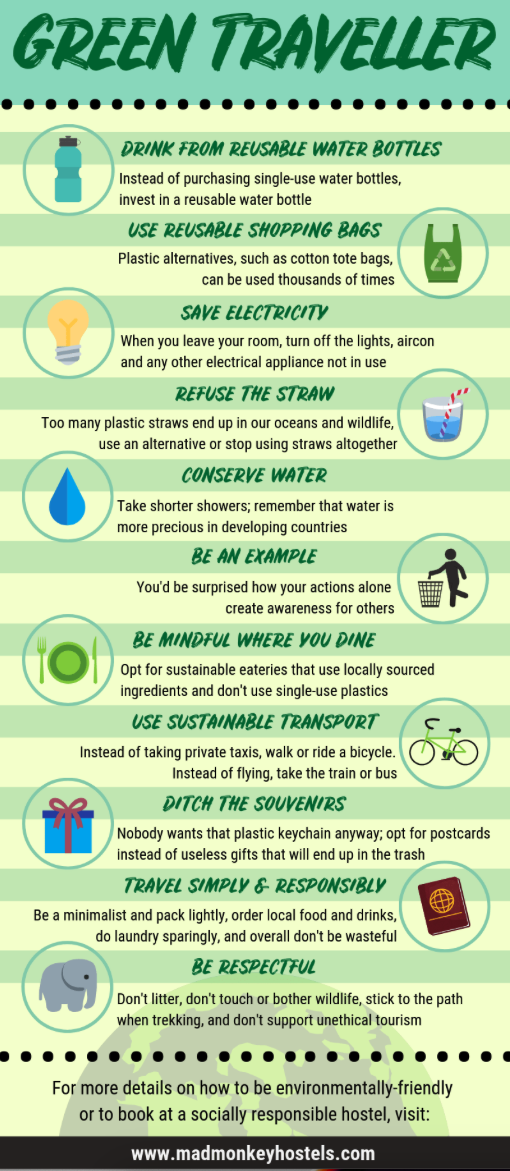
Source: Mad Monkey Hostels
Tips:
- Promote eco-friendly practices and highlight your commitment to environmentally responsible practices, such as minimising waste, reducing your carbon footprint and supporting conservation efforts.
- Engage solo travellers in community-based tourism experiences, highlighting the positive impact tourism can have on the local economy and culture.
- Give your guests simple tips on how they can travel more sustainably.
- Read the CBI study How to be a sustainable tourism business for more ideas on practices you can implement to improve your business’s sustainability.
What are the requirements for niche markets?
Solo travellers differ from other travellers in what they look for in a destination or a tour operator. They need detailed information in order to feel comfortable and safe when booking a trip. They also want to have the opportunity to make authentic connections both with locals and other travellers. As solo-friendly packages will attract this group, it is important to understand these needs so you can successfully target this market.
Provide detailed information
Providing detailed information for solo travellers is critical for businesses that want to attract this niche. Solo travellers have distinct needs and preferences. These needs are often characterised by a desire for independence, safety and a sense of community. By offering detailed information, tour operators can support solo travellers throughout their travel experience. It is important to provide the following information:
- Transparency about costs. Solo travellers rely on research and planning before a trip. They like it when tour operators are upfront about what is included in the package and what is not. This includes clear information about the tour itinerary, any additional costs (like single supplements) and optional activities. Transparency builds trust.
- Safety and security information. Solo travellers may have more concerns about safety than other travellers. Tour operators should provide details about safety measures, local regulations and any risks in the areas they operate in (see Figure 2 below). Offering tips on personal safety and health recommendations can also help solo travellers feel more secure.
- Information about accommodation options. Tour operators should provide information about the types of accommodations included in the package – whether they offer single rooms, shared dormitories or other options. Clear descriptions of the lodging facilities, the included amenities and the safety protocols are important to help solo travellers make travel decisions.
- Group makeup. Group dynamics play a big role in solo travellers’ decisions. Tour operators should specify the group size and demographics where available. This makes it easy for solo travellers to assess whether the tour matches their preferences for social interaction. Some solo travellers may prefer smaller groups for a more intimate experience, while others might want larger groups for a more communal experience.
- Information about local culture and customs. Solo travellers often want to engage with the local culture. Giving travellers insights into local customs, traditions and etiquette can improve their travel experience. It also helps travellers understand any cultural differences and act respectfully.
- Communication channels. Solo travellers may have more questions or concerns than other travellers. Businesses should provide multiple contact options for solo travellers. Access to assistance can inspire confidence amongst this group.
You may choose to provide some or all of this information through your website, marketing materials or even blogs about solo travel. Figure 2 provides an example of how Intrepid offers information specific to solo travellers on its website.
Figure 2: Example of information provided to solo travellers
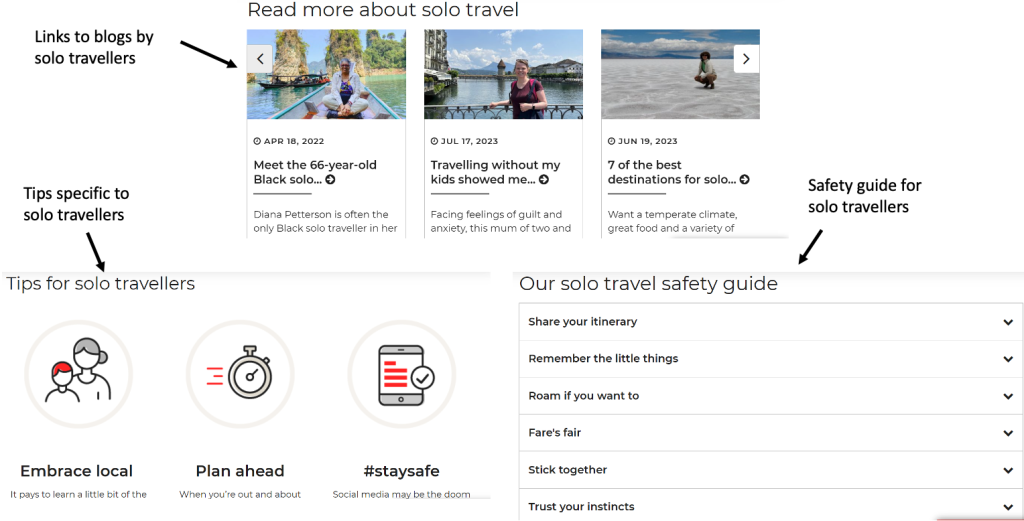
Source: Intrepid Group
Tips:
- Offer solo travellers multiple ways to contact you. Be clear about response times and offer 24/7 support during their tour.
- Be upfront about the costs and pricing structure of your tour. Provide a breakdown of what is included in the package and what is not. Highlight any added expenses for solo travellers.
- Emphasise the safety measures you have in place during the booking process to help solo travellers feel more comfortable.
- Clearly outline the type of accommodation on the tour and whether solo travellers will sleep in single rooms, shared dormitories or shared twin rooms.
- Provide solo travellers with details about the group if they ask for them (how many people have already booked, will there be other solo travellers, etc.).
Provide opportunities to make authentic connections
Solo travellers often want the opportunity to make authentic connections when they travel. Authentic connections can enrich travel experiences and help combat the feelings of loneliness people sometimes experience on solo trips. Solo travellers want to connect both with locals and fellow travellers.
There are many ways for solo travellers to make authentic connections. For example, they may want to engage in conversations with locals, share meals and conversations with other travellers or get involved in community activities. Tour operators can help solo travellers have authentic experiences with locals by offering some of the following activities:
- Homestays where solo travellers can stay with and learn from local families.
- Community-based tourism: supporting community initiatives through interactions with indigenous communities and by learning about their way of life.
- Tours given by local guides who can share personal stories and teach travellers about their culture.
- Cultural immersion activities like cooking classes, visiting local markets, watching local musicians perform or going to cultural performances.
Solo travellers also want the opportunity to make authentic connections with other travellers. For many solo travellers, connecting with other travellers is one of the main reasons they choose group tours rather than travelling independently. Tour operators can help tour groups bond by offering:
- Small group tours: smaller groups make it easier for travellers to interact and make friends.
- Group meals: arranging a few group meals at local restaurants encourages travellers to sit together and socialise during the trip.
- Social activities: organising game nights, cultural performances or nights out can create a more relaxed environment for travellers to interact.
- Common areas: choosing accommodation options with common areas can encourage group members to interact between planned activities.
Tips:
- Include cultural immersion activities as part of the tour, like visits to local markets and cultural performances.
- Consider adding homestays or community-based tourism options to trips so solo travellers can have authentic experiences with local communities.
- Create a plan to encourage bonding on your tours, for instance through activity nights and shared meals.
Provide solo-friendly packages
Solo travellers make up a large portion of the tourism industry, accounting for up to 18% of global travel bookings. So it is essential that tourism businesses start offering products designed specifically for this market. By creating packages targeted at solo travellers, tourism businesses can tap into this market’s preferences and interests.
To reach solo travellers, tourism operators should highlight solo-friendly features in their packages. This includes promoting group tours that facilitate social interaction, offering single-room options and activities that allow for individual exploration. By showcasing these features, you can communicate your commitment to catering for the specific needs of solo travellers. Here are some ideas on how to offer products aimed at this market:
- Offering solo traveller discounts or promotions can be a great way to reach this market. Travelling alone can sometimes be more expensive, but special rates or reduced prices for longer stays can make solo travel more budget-friendly and more appealing.
- Tourism businesses can highlight how they help solo travellers meet their expectations. For example, they can mention that their travel experiences provide a sense of freedom and adventure. This can help you connect with solo travellers on an emotional level and encourage them to choose your products.
- Collaborating with solo traveller-friendly accommodation providers can improve solo travellers’ experience. These accommodations will likely have cheaper rooms for solo guests and are safe and comfortable for all travellers.
- Offering flexible experiences can allow solo travellers to choose activities or itineraries that match their own preferences and interests.
- Businesses can offer travel options for single travellers without additional charges, such as airport transfers or meals paid per person rather than per room. One effective way to build trust and confidence amongst solo travellers is by using reviews. Sharing stories and testimonials from solo travellers who have had positive experiences with your company can be beneficial. These first-hand accounts can reassure solo travellers and encourage them to use your company.
Tips:
- Emphasise features of your group tours that will be attractive to solo travellers, like single-room options without an extra charge.
- Tailor your marketing to appeal to the emotions of solo travellers, for instance by highlighting the sense of freedom they will experience.
- Use positive reviews from solo travellers on your website to show potential customers what solo travellers have enjoyed about your trips in the past.
- Provide flexible itineraries and activity options that allow solo travellers to create their own unique journey.
2. What channels can you use to bring solo tourism products to the European market?
Most solo travellers use online booking platforms like online travel agencies (OTAs) when making reservations, or they make direct bookings. OTAs are useful for this group as they show reviews, making it easier to find companies with a good reputation. Direct bookings allow solo travellers to personalise their itinerary, while also giving tourism businesses more control over their marketing methods.
How is the end-market segmented?
The solo travel market can be segmented by a number of characteristics, including:
- Age: travellers under 50 and those over 50
- Gender: male and female solo travellers often have different requirements
- Budget: budget and luxury travellers
- Purpose of trip: travelling for business or leisure
- Activities: solo travellers are diverse in the activities they like to do when they travel
It is important to understand that different segments of this group will have different preferences, priorities and characteristics. More information on the market segmentation of the solo niche market can be found in the CBI study The European market potential for solo tourism.
Through what channels do solo tourism products reach the end-market?
Many solo travellers rely on the internet and digital platforms to research and book their trips. This means that travel agents or advisers are used less by this market. Tourism businesses should use digital platforms and tools for marketing and bookings where possible. The main channels for reaching the European solo market are OTAs, outbound tour operators and direct bookings (Figure 3).
Figure 3: Best channels to reach solo travellers
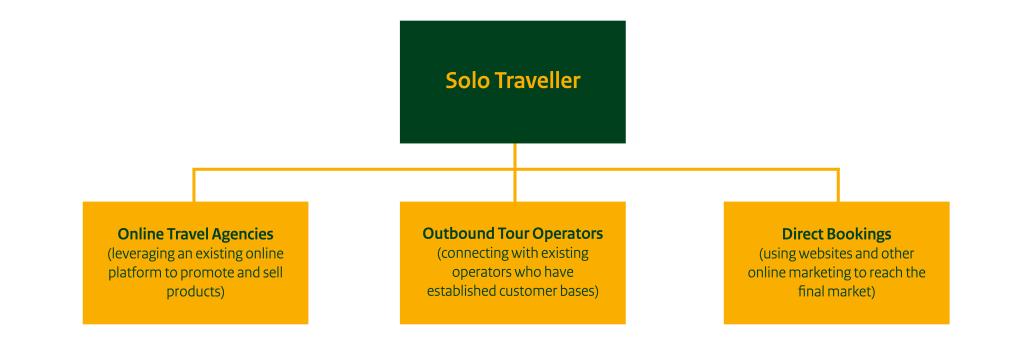
Source: Acorn Tourism Consulting
Online travel agencies
OTAs provide travellers with access to thousands of options for accommodation, tours and flights when they book their trips. Some of the larger OTAs can offer small businesses excellent visibility and provide access to a wide global audience of potential solo travellers.
Some of the largest OTAs are seen as highly trustworthy and credible by customers. These include:
- Solo Traveler: this OTA specifically caters for solo travellers, who never have to pay more than a 20% surcharge to have their own room (single supplement). Not all trips are exclusively for solo travellers.
- Booking.com: one of the largest OTAs in the world, offering hundreds of thousands of accommodation options globally. Booking.com has a good reputation with travellers thanks to its competitive prices and user-friendly booking options.
- Expedia: offers a range of travel services, including flights, hotels, tours, car rentals and activities.
- Agoda: Agoda specialises in accommodation. It offers competitive rates and sometimes has special deals for solo travellers.
- Tripadvisor: the most well-known and trusted platform for travel reviews and recommendations. Tripadvisor also has a booking engine that allows travellers to book hotels, flights and tours.
- Viator: one of the largest and most well-known platforms for booking tours and activities. Its tours range from single-day city sightseeing excursions to multi-day adventures.
- GetYourGuide: a global platform that offers a wide range of tours and activities. Travellers can find guided tours, unique experiences and tickets that allow them to skip the queue at popular attractions.
Solo travellers exploring new and unknown destinations often rely on customer reviews in making their travel decisions. Most OTAs provide easily accessible reviews on their platform, making it easy to choose good companies. If you are seen as trustworthy by solo travellers, you will receive a lot more bookings from this group.
Outbound tour operators
Outbound operators in source markets offer a great way to reach the target solo market. Inbound tourism operators in developing destinations can identify reputable outbound tour operators that specialise in sending travellers to their region or similar destinations. These tour operators often have established customer bases looking for new travel experiences. Inbound operators can reach out to these outbound operators and express their interest in forming a partnership. The goal is to become part of the tour operator’s portfolio of destinations and experiences.
Inbound operators will need to come up with itinerary ideas that meet the requirements of outbound operators, for instance by creating specialised packages and experiences that cater for the preferences and interests of solo travellers. These might include solo-friendly accommodations, group activities, cultural immersion opportunities, and personal growth and wellness activities.
The benefits of partnering with outbound operators include:
- The ability to collaborate on marketing efforts. Smaller operators in developing destinations can create marketing materials that showcase their unique experiences and leverage the outbound operator’s marketing channels and customer reach.
- Many outbound operators will provide training to in-country staff to accommodate their requirements and meet the needs of solo travellers. Friendly, knowledgeable guides and good safety measures can enhance the experience travellers have.
Larger outbound tour operators that often partner with locally run inbound operators include some of the biggest names in travel. There are many operators globally, but some of the more well-known ones are listed below. All these operators either target solo travellers specifically or have tours marketed to solo travellers.
- Intrepid
- G Adventures
- TUI Group
- World Expeditions
- Flash Pack
- Explore
- Exodus Travels
Direct bookings
Solo travellers enjoy flexibility and being able to make their own decisions. Direct bookings allow these visitors to personalise their itineraries to meet their needs. By booking directly with businesses, solo travellers can choose to either book their own accommodation, activities, flights and transportation, or to find a package tour that ticks all their boxes.
The following tourism operators market directly to their end-market:
- Yampu Tours does a great job of marketing directly to its consumers. Its website is easy to navigate, allowing visitors to search for tours by destination and experience, and there is a chatbot that can answer questions. Yampu Tours also runs a travel blog to advertise specific countries, and it has an Instagram account that shares videos and photos of popular destinations like Egypt, Jordan, Bali and Peru. The website has a promotions page as well, so potential clients can search for the best deals for their next trip.
- Grasshopper Adventures is a tour operator in Southeast Asia that sells bike tours. Guests can find tours that fit their needs through the company’s easy-to-use website, and they can book and pay online without hassle. They can also add optional extras to their package at checkout. Tours can be guided or self-guided, both of which may be attractive to solo travellers, depending on their travel style. Grasshopper Adventures has a popular Instagram page where it shares stories and extra information about its tours, accompanied by beautiful photos and videos to attract potential guests.
Figure 4 below shows a range of tools that can be used by direct booking channels to market to solo travellers. It also shows how these tools can be used. It is important to make the research and booking process as simple as possible by offering an accessible website and easy payment, as well as a chatbot or online support for instant assistance.
Businesses should also use both social media and content marketing to reach solo traveller markets. These types of marketing are more popular now and are critical when trying to reach travellers who use their smartphones during the booking process.
Finally, review websites are a great way to advertise to solo travellers. This group uses reviews to make sure that their trip will be safe and comfortable. You need to keep track of your review ratings and respond where necessary. If you get the same negative feedback from multiple reviewers, make changes to your business to address the problem.
Figure 4: Direct marketing methods to reach solo travellers
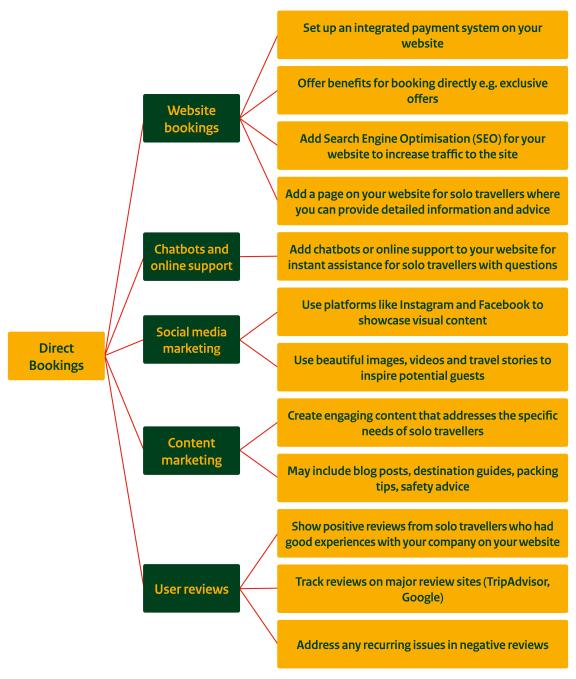
Source: Acorn Tourism Consulting
Tips:
- Showcase positive reviews and testimonials from solo travellers.
- Partner with trusted OTAs that have a good reputation amongst solo travellers.
- Make booking processes as simple as possible. If you do not offer online payment on your website, use an OTA for this.
- Use a chatbot or customer service representatives to help solo travellers with questions and bookings.
- Learn more about using online marketing. Read the CBI studies How to be a successful tourism company online? and 10 tips to go digital in the tourism sector.
What is the most interesting channel for you?
Give priority to the marketing channels that are most accessible to your business. OTAs provide a convenient way to reach a wide market, take reservations and process payments. OTAs are also very popular with solo travellers because they offer reviews and a simple booking process. The downside of using OTAs is that they usually take a commission on all bookings, so it is important to understand these charges and how they will impact your business.
Tips:
- Calculate the financial impact of using an OTA to ensure that you will still make a profit before you sign up.
- Monitor how well your tours are selling on which platforms so you can make changes where needed.
- Use OTAs for payments if your company website does not have an online payment portal.
- Get more information on how to work with OTAs from CBI’s tourism platform.
3. What competition do you face in the European solo tourism market?
Solo travellers look for destinations that are safe and budget friendly, and that provide an opportunity to meet other solo travellers. Even if solo travellers use a tour operator, they will still need to choose a destination first, which means that destinations are competing to attract this market. There is also competition within these destinations, with different operators successfully selling products to solo travellers. It is useful to understand what successful destinations and operators are doing to attract this market.
Some popular destinations for solo travellers your destination might be in competition with are Cambodia, Tanzania, Costa Rica, Sri Lanka, Bali and Jordan.
Which countries are you competing with?
Cambodia and Bali (Indonesia) are popular solo travel spots because of the large number of tourists they attract each year. This provides a great opportunity for meeting other travellers and socialising. Other destinations, such as Tanzania, Costa Rica, Sri Lanka and Jordan, are popular with solo travellers because they are home to excellent historic, cultural and natural sites. These destinations are quieter but offer more once-in-a-lifetime experiences for solo travellers.
Cambodia
Cambodia was recently named one of the best countries in the world for solo travel. The ranking was based on availability, cost and ratings of a number of relevant components for solo travellers, including accommodation, attractions, day trips, group tours, national parks, transport and safety. Cambodia was the top developing destination on the list, placing seventh overall with a score of 85.76. The reason Cambodia did so well is that it is a great place to travel alone, as well as one of the most affordable destinations.
Solo travellers in Cambodia can explore ancient temples, learn about Khmer culture, experience interesting landscapes and activities, relax on local islands, and find out more about the country’s dark history. Cambodia has more than 1,100 hotels, and the average price for solo travellers is $60.70 per night. Moreover, an average day trip costs only $41. It must be noted, however, that Cambodia is relatively unsafe compared to some other countries. If this were to improve, it could rank even higher.
Figure 5: Never alone at Angkor Wat, Cambodia
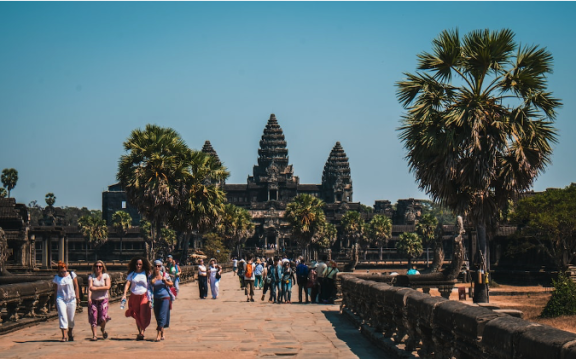
Source: Silver Ringvee at Unsplash
Tanzania
In 2019, 52% of people who visited Tanzania travelled there alone. This was the largest group of travellers, followed by those who travelled with their spouse (19%). By 2022, the number of people travelling alone had increased to 57% of all visitors. Tanzania also ranked 13th out of 193 countries in a recent ranking of the best places to travel solo.
Tanzania is an excellent destination for solo travellers due to its diverse natural beauty and rich cultural experiences. The country’s iconic national parks, including the Serengeti and Ngorongoro Crater, offer opportunities for safaris, where solo travellers can witness the wildlife of Africa. Tanzania is also home to Mount Kilimanjaro, providing adventurous solo trekkers with the ultimate challenge.
Beyond its natural wonders, Tanzania has a welcoming and interesting culture. Solo travellers can immerse themselves in the traditions of local tribes, such as the Maasai, and explore markets and historical towns like Stone Town in Zanzibar. The country’s tourist infrastructure, with well-organised tours and comfortable lodges, ensures easy travel for solo adventurers. Tanzania also has a reputation for safety and hospitality that makes it an ideal choice for those looking to explore Africa independently.
Costa Rica
Costa Rica is a popular destination for solo travellers, ranking 14th out of 193 countries in terms of availability, cost, accommodation, attractions and other relevant aspects. The country is popular with solo travellers due to its safety and beautiful natural landscapes. Costa Rica offers a lot of adventure activities, like hiking, surfing and wildlife watching.
The country is well-known for its eco-conscious approach to tourism, which will attract solo travellers that want to make a positive impact as they travel. Costa Rica also has a wide range of solo-friendly accommodation options, including many hostels, and there are many public transport options. It is rich in culture as well, providing an opportunity to make authentic connections with locals.
Sri Lanka
In 2018-2019, 20% of visitors to Sri Lanka travelled alone. This was the third most common way to travel, after travelling with friends and relatives (36%) and travelling with a spouse (29%). Sri Lanka is a popular place for solo travellers because it is relatively safe and welcomes a large number of visitors each year. The country offers a range of hostel accommodation options for solo travellers who want to meet new people. It is also served by many international tour operators that offer tours targeted at solo travellers.
There are lots of beautiful places to visit in Sri Lanka, and the country is welcoming to people travelling alone. It is not too expensive, making it attractive to travellers on a variety of budgets. Solo travellers can see ancient temples and stunning nature, and enjoy the warm hospitality of the local people. Getting around is easy, and there are many things to do, like hiking, going on safaris or just relaxing on the beach. Additionally, most people can understand and speak English, which makes communication easier.
Figure 6: Train travel in Sri Lanka
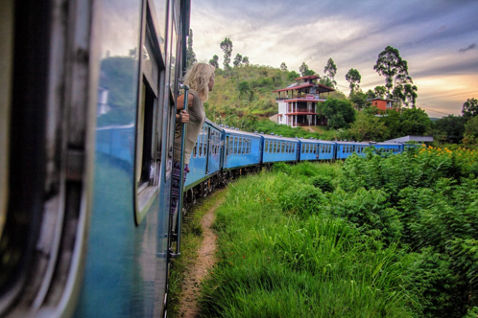
Source: Yves Alarief at Unsplash
Indonesia (Bali)
Indonesia ranks 34th out of 193 countries as a solo travel destination. Bali is a budget-friendly destination for solo travellers, with affordable accommodation and dining options. There are many adventure activities available for solo travellers, as well as cultural experiences such as exploring Hindu temples, attending ceremonies and discovering artistic traditions. The island is home to diverse landscapes with many photographic scenes such as rice terraces, pristine beaches and volcanoes.
Bali is popular with all types of travellers and has a strong community feel, with plenty of opportunities for solo travellers to meet other people. Bali’s reputation as a wellness hub also provides a perfect opportunity for solo travellers seeking relaxation and rejuvenation.
Jordan
Jordan ranks 37th out of 193 countries in terms of its attractiveness to solo travellers. Jordan is a bucket-list destination, with a unique blend of historical wonders, natural beauty and interesting culture. The country’s historical sites, including the ancient city of Petra and the Roman ruins of Jerash, offer visitors an opportunity to step back in time. The Wadi Rum desert and the Dead Sea allow solo travellers to immerse themselves in natural beauty.
Solo travellers in Jordan can choose from more than 1,300 hostels, with an average rating of 8.76 out of 10. Additionally, Jordan is renowned for its safety and the friendliness of its people, making it a comfortable and welcoming destination for solo travellers. The country has well-maintained roads and reliable public transport, allowing solo travellers to get around easily without paying for private transfers.
Figure 7: Enjoying Petra solo in Jordan

Source: Mauro Lima at Unsplash
Key takeaways:
- Solo travellers often seek budget-friendly destinations, so affordable destinations – like Cambodia and Bali – rank high for this group.
- Safety is also a concern for solo travellers, especially for women. Destinations like Costa Rica, Sri Lanka and Jordan are popular solo destinations because of their good safety records.
- Solo travellers will often choose destinations that provide opportunities to engage with and meet other travellers. Destinations like Sri Lanka and Cambodia offer an array of hostels for solo travellers and provide great opportunities for socialising.
- Destinations with diverse attractions will help attract solo travellers with different activity preferences. Tanzania offers travellers national parks and wildlife, beautiful beaches and challenging hiking trails, attracting a wide range of solo travellers.
Which companies are you competing with?
When building or perfecting products for solo travellers, it is useful to review successful tours offered by operators in competing countries. Comparing your own tour with these products can give you an insight into what is already available to solo travellers, how operators are attracting this market, and some of the key features of successful tours.
Take a look at the companies below to see if there are any best practices you could implement in your own company. Gain new ideas from competitors to become a leader in the solo travel market.
Cambodia
Soksabike offers unique bicycle tours in the Battambang region of Cambodia. It is a social enterprise that aims to promote sustainable tourism and support local communities by hosting small half- and full-day group tours. These tours allow travellers to get acquainted with Cambodian communities. They are perfect for solo travellers who want to make authentic connections and learn about local cultures.
Journey Cambodia is a company that offers tours to many of Cambodia’s most popular regions. Most of these are day tours in small groups, allowing solo travellers to interact with each other. Journey Cambodia also offers private tours for solo travellers on a larger budget who want to have a more personalised experience. Many of the company’s tours centre around authentic experiences, like eating street food or visiting temples.
Tanzania
Sababu Safaris is a local tour operator that offers luxury safaris in Tanzania’s national parks. The company offers a Tanzania solo safari tour option as an opportunity for solo travellers to take their dream trip. Solo travellers can either select an existing tour package or design their own perfect safari, and they get their own safari guide and four-wheel drive. The website provides detailed information for solo travellers, including about safety in Tanzania. Because these solo safaris are a luxury product, they are targeted at a specific segment of the solo traveller market.
Kivolex is a volunteer organisation in Tanzania that provides access to volunteer programmes for travellers. Solo travellers can book a spot on one of these programmes, with prices that include accommodation (shared with other volunteers or with local host families). Volunteer programmes cater for a range of solo travellers’ interests, including wildlife and animal care, environmental protection, women’s empowerment, supporting NGOs, construction and medical support. Before they leave home, volunteers receive information packages about health, safety and applying for a visa.
Costa Rica
Monteverde Tours in Costa Rica offers adventure tours. It sells both package tours and custom adventures, mostly without guides. The company also has tours specifically designed for solo travellers, which can last from two days to a week. The packages include all accommodation and transportation, as well as some meals and activities. On its website, the company underlines the safety of its offer, marketing this as a benefit compared to booking your own trip.
Costa Rica Experts offer both holiday packages and custom-made trips. This allows travellers to create their own itinerary. The website highlights three packages recommended for solo travellers, with trips lasting eight to nine days. Unfortunately, the company still charges a single supplement, meaning solo travellers have to pay full price for rooms that would otherwise be shared by two adults. The website provides information for solo travellers, including answers to frequently asked questions like ‘is Costa Rica safe for solo travel?’ and ‘why should I travel solo in Costa Rica?’
Sri Lanka
Experiential Journeys Sri Lanka is a tour operator that focuses on creating authentic encounters with local communities. It provides tours that allow travellers to learn about the history and culture of some of Sri Lanka’s largest towns. Other tours offer close encounters with wildlife or the opportunity to engage in cultural practices, like cooking, meditation and yoga, and ayurveda. The company is passionate about sustainability, particularly with regard to reducing tourism’s exploitation of wildlife and people.
Ayubowan Tours offers various kinds of multi-day tours around Sri Lanka. Solo travellers may be interested in the company’s adventure, cultural, festival, nature and wildlife, or wellness tours. The company provides clear information, and the website offers details about pricing and tour inclusions. It also provides contact details for 24/7 customer support.
Indonesia (Bali)
Solo Kiwi Ventures is a small tour operator based in New Zealand that hosts tours in Bali, the Gili Islands and Rarotonga. The tours are designed specifically for women over the age of 40 who are looking for adventure and new experiences. The tour in Bali is a wellness and revitalisation retreat, allowing travellers to relax, recover and rebalance. It also gives them a taste of life in Bali and an opportunity to taste local food.
Feel Free offers group tours in Bali, for both solo travellers and people travelling in groups. The company highlights the fact that it serves a lot of solo travellers, and that there is ample opportunity to make new connections. Tours include accommodation, activities and some meals. Single travellers sleep in shared dorms to avoid the need for a single supplement. Frequently asked questions are answered on the website.
Jordan
Experience Jordan Adventures is an adventure tour operator. While it specialises in adventure activities like hiking and cycling, it also offers cultural experiences. Tours range from single-day excursions to nine-day trips. Solo travellers can choose to share a room with another traveller, or pay a single supplement of around $250 to have their own room. The company focuses on creating a positive group environment, giving solo travellers the opportunity to connect with others.
Wadi Rum Nomads provides unique experiences in the Wadi Rum desert. Guests can book tours ranging from one to five days in length. They also have the option to do a hike in the desert, or to travel by car. This makes the tour attractive to a range of solo traveller segments. Tour prices are based on the number of travellers making the booking. Solo travellers pay €80 more than those booking for two (per person). The tour itineraries provide useful information about accommodation options and any available upgrades.
Key takeaways:
- Small group tours create an intimate and social atmosphere that allows solo travellers to connect with others.
- Solo travellers like authentic and immersive experiences. Many successful operators promote these experiences and create opportunities to make authentic connections, like participating in cultural activities.
- The solo travel market is diverse. Tour operators should provide different options for solo travellers to customise their itineraries or choose from a variety of themes.
- Clear information is important to solo travellers. Answers to frequently asked questions and safety information should be provided during the booking process.
- Sustainability and responsible travel are important to solo travellers. Integrate these elements into your core business model and promote this on your website.
Which products are you competing with?
Tourism businesses aiming to attract solo travellers face competition from an array of products and experiences. Solo travellers may choose to travel independently or join group tours or guided tours. Group and guided tours appeal to those who prefer structured itineraries and local expertise, as well as the chance to connect with like-minded travellers. Tour operators will be competing with other products available to this group, including:
- Adventure packages for activities like trekking, diving and wildlife encounters.
- Cruise vacations (some cruise operators offer trips for solo travellers only).
- Wellness retreats for relaxation and personal growth.
- Volunteer programmes and cultural engagement.
Tips:
- Tailor experiences to different kinds of solo travellers. Highlight the unique aspects of each product, emphasising the ways they cater for solo travellers, for instance by providing opportunities to meet like-minded individuals or have meaningful experiences.
- Create opportunities for solo travellers to connect with fellow travellers through group activities, meetups or themed events.
4. What are the prices of solo tourism products?
Solo travellers may travel independently or choose to join group tours. Group tours may be day trips at a popular destination or multi-day trips that last one or two weeks, or even up to a month. The prices of these tours depend on the destination, the duration of the trip, the accommodation quality and the trip inclusions.
Some tour operators may charge solo travellers a ‘single supplement’ fee to cover the cost of a double room. It is important to be very clear about any additional charges for solo travellers on the booking platform. Most of the single supplements in Table 1 are optional (for travellers who want a single room instead of sharing a twin room with another traveller).
Tour operators need to understand the market pricing of existing travel products for solo travellers. This can help you understand how to price your own products. Table 1 gives an indication of the prices of tours available today, excluding international airfares.
Table 1: Prices per person (pp) of products for solo travellers in competing destinations, October 2023
| Trip | Country | Duration | Price from (€) pp | Single supplement (€) pp |
| Day trips | ||||
| Local Livelihood Bike Tour | Cambodia | 7 hours | 40 | N/A |
| Mount Batur Sunrise Hike and Natural Hot Spring | Bali | 7-10 hours | 40 | N/A |
| Yala National Park Safari Tour | Sri Lanka | 8 hours | 72 | N/A |
| Monteverde Cloud Forest Hike | Costa Rica | 4 hours | 80 | N/A |
| Zanzibar: Stone Town, Spice Tour and Prison Island | Tanzania | 11 hours | 120 | N/A |
| Petra 1 Day Tour | Jordan | 10 hours | 175 | N/A |
| Experiences up to 2 weeks | ||||
| Costa Rica Budget Package for Solo Travellers | Costa Rica | 5 days | 770 | N/A |
| Cambodia Adventure | Cambodia | 12 days | 940 | N/A |
| Costa Rica Solo Budget Package | Costa Rica | 7 days | 950 | N/A |
| Beautiful Bali | Bali | 9 days | 990 | 250 |
| Explore Jordan | Jordan | 8 days | 1,365 | 190 |
| Inside Sri Lanka | Sri Lanka | 12 days | 2,420 | N/A |
| Wild Tanzania | Tanzania | 9 days | 5,395 | N/A |
| 2- to 4-week holidays | ||||
| Three-week volunteer programme | Tanzania | 3 weeks | 530 | N/A |
| Best of Cambodia | Cambodia | 14 days | 1,740 | 370 |
| Classic Costa Rica | Costa Rica | 15 days | 1,925 | 720 |
| Best of Sri Lanka | Sri Lanka | 15 days | 2,155 | 660 |
| Java & Bali Explorer | Bali | 22 days | 2,800 | 635 |
Source: Acorn Tourism Consulting
Tips:
- Assess whether you can offer options for solo travellers without adding a single supplement fee. You might be able to do this by placing solo travellers in rooms together, or by choosing accommodation options with cheaper single rooms.
- Research tours in your own destination. Look at different durations, accommodation types and activities. Compare your prices to check your competitiveness.
- For more help on setting prices, consult the CBI study 10 tips for doing business with European tourism buyers and see tip 7, Set a fair price for your services.
Acorn Tourism Consulting Limited carried out this study on behalf of CBI.
Please review our market information disclaimer.
Search
Enter search terms to find market research
